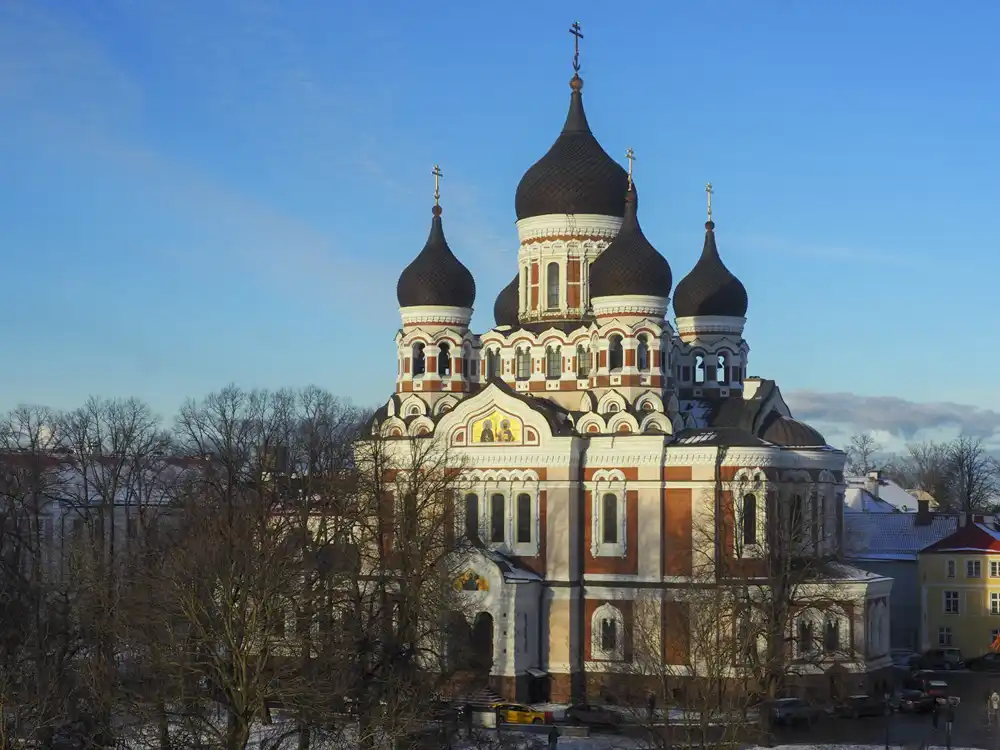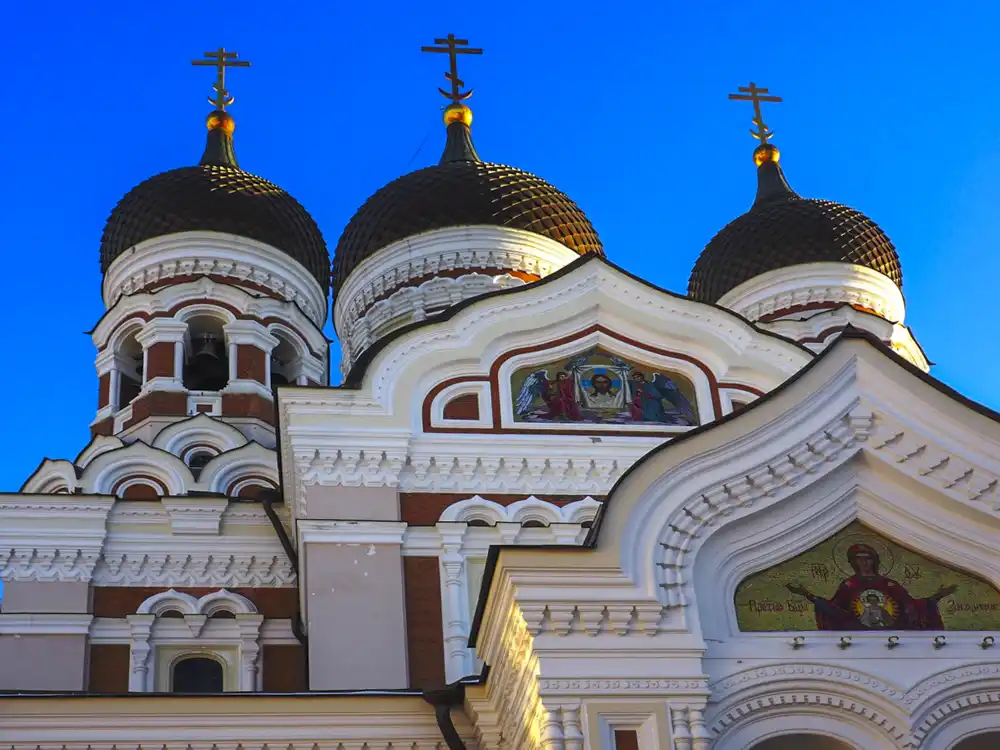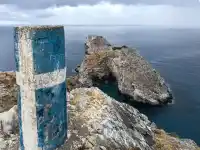I fell in love with the Baltics 25 years ago when I first visited Tallinn. Last year, I decided to rediscover the charm of this region. After exploring Lithuania and Latvia, I knew I had to return to Estonia as well. It was a fantastic decision to experience Tallinn during the lead-up to Christmas. Weekend in Tallinn:
Zuzka and I arrived in beautiful sunny weather, but by the time we reached our hotel, it had started to snow. Initially, the snow was light, but soon it turned into a steady drizzle, creating the perfect setting to enjoy the local Christmas markets. We checked into our hotel after dark, so we decided to postpone our exploration of the town until the following day. Our first destination would be the historic center, where our main goal was to visit the Christmas market.

Christmas Markets in Tallinn
As we wandered through the charming alleys of the Old Town, we arrived at Town Hall Square, where we were immersed in a delightful pre-Christmas atmosphere. This year, Tallinn’s Christmas market was ranked among the top 20 Christmas markets in the world, and it’s easy to see why. The market features a fairytale setting, enhanced by its location in the medieval city center. Town Hall Square is lined with stalls offering handmade crafts and unique Christmas gifts. Visitors can indulge in sweet treats and traditional Estonian specialties, including the local rum, Vana Tallinna. The centerpiece of the square is an enchanting Christmas tree that has been displayed here every year since the 15th century. In recent years, a stage has also been added, hosting concerts by local and international artists on weekends.



We enjoyed a wonderful Christmas atmosphere under Tallinn Town Hall, complete with delicious food and grog. We danced in the snow with St. Nicholas and later had a chance to return to the hotel to rest and recharge our batteries for the next day.
Things to See in Tallinn
Tallinn is one of the best-preserved walled cities in Europe. The ramparts stretch along both sides of the Old Town, allowing visitors to enter the historic city center through various gates that are part of the fortifications.
Since our accommodation was on the coast, we chose to enter the city through the Great Coastal Gate, which marked the beginning of our tour of historic Tallinn. Closely associated with the Great Coastal Gate is Fat Margaret, a tower that is part of the city walls. Built in the early 16th century as part of Tallinn’s defensive system, the tower was designed to protect the city’s harbor and the northern entrance. It is said to have received its name due to its massive construction and thick walls.



Pikk
As we passed under the gate, we arrived at Pikk Street, one of the main thoroughfares in the city. At the very start of the street, we encountered the Three Sisters, a trio of Hanseatic houses dating back to the 15th century. During our visit to Riga a year ago, we admired a similar set of historic buildings known as the Three Brothers. We were eager to see the Tallinn equivalent, the Three Sisters. Fortunately, we found them right at the beginning of our walk around the city. The three houses stood side by side, still huddled together like their namesake. According to our guidebook, there was supposed to be a luxury hotel in this location, but that is no longer the case, and the houses are currently for sale.



We continued walking along Pikk Street, where German merchants once had their homes. The street is lined with charming, old, and colorful houses. One particular building caught our eye: a beautiful Art Nouveau house. Above its gate, there was a sign indicating that the KGB Museum was located there. Ironically, in such a lovely house, there used to be KGB prison cells and interrogation rooms. The windows from the street to the basement were bricked up to prevent any sounds from escaping. The museum doesn’t open until 11 a.m. during the winter months, and it was still closed when we arrived. So, we decided to skip the tour and continued down Pikk Street.
Blackheads

On this street, you can find the building of the House of the Blackheads Brotherhood. This guild was composed of young free merchants who organized the town’s defenses and arranged regular tournaments. The guild was named after its patron saint, St. Maurice, who was dark-skinned. While the House of the Brotherhood of Blackheads in Tallinn may not be as beautiful as the one in Riga, it is noteworthy that the Brotherhood began its history in Tallinn. The building features a typical entrance door.
Adjacent to the House of the Brotherhood of Blackheads is the building of the Guild of St. Olaf, followed further down by the building of the Guild of St. Canute.
Tallinn Town Hall Square
We walked through the small square, where the photogenic Church of the Holy Ghost is located. A few meters later, we entered a narrow alley that led us to Town Hall Square for the first time that day. Compared to the previous day, the square was less crowded. However, the Christmas market was lively and bustling. Tourists consider Town Hall Square to be the heart of the city. It is dominated by the Gothic Town Hall, and the rest of the square is filled with charming pastel-colored houses. The town hall also includes a tower that offers a magnificent view of the entire town. Unfortunately, we didn’t get a chance to go up there. Access to the tower is only permitted during the winter months by phone reservation, and we didn’t find out in time. (The phone number is listed on the opening hours notice).
Pharmacy Raepteek


Since we couldn’t visit the town hall or the town tower, we at least enjoyed a trip to the town’s apothecary in the town square. The Raepteek pharmacy is somewhat easy to miss due to its inconspicuous facade. However, behind it lies one of the oldest pharmacies in the world, where medicines have been sold continuously since 1422.
From Town Hall Square, we headed towards the Toompea Citadel. Signposts, which are conveniently placed at every turn in Tallinn, made it easy for us to navigate the city. As we climbed up, we walked alongside the walls until we reached the Orthodox Alexander Nevsky Cathedral. This cathedral is the largest Orthodox church in Tallinn, built at the turn of the 19th and 20th centuries. It boasts five gilded domes and magnificent mosaics and is dedicated to St. Alexander Nevsky, a symbol of the defense of Russian Orthodoxy against Western influences.
Toompea

On Toompea Hill, just a short walk from Alexander Nevsky Cathedral, stands the medieval fortress of Toompea Castle. It is often referred to as a palace with two faces, reminiscent of the Roman god Janus. From the direction we approached, the castle’s facade is adorned in a pink Baroque style, attributed to the era of Catherine the Great. In this area of Toompea, there are several viewpoints that offer stunning panoramas of the historic town center, making it feel as if the entire town rests in the palm of your hand.
After fully appreciating the beauty of the town from the hill, we made our way down to our next destination: the Kiek in de Kӧk tower. This massive five-story structure was once one of Tallinn’s most formidable defensive fortifications. Its name translates to “Peek into the kitchen,” which reflects the fact that from the tower’s height, onlookers could spy on the kitchens of the Lower Town. The museum located within the tower, designed by Estonians, focuses on military history. Exploring the underground of Tallinn…
The Tallinn underground


We walked smoothly from the museum to the underground passages, which were built in the 17th century by the Swedes. For many years, these tunnels served not only as shelters but also as a refuge for the homeless and as rehearsal spaces for alternative bands. We concluded our tour of the tunnels with an exhibition of stone carvings from Tallinn.
Tourist guides recommend making a reservation for the underground passage tour; however, this may not be necessary during the winter months. We managed to get on the tour without a reservation, and for most of our time in the underground tunnels, we had the place completely to ourselves.
You can purchase entrance to the underground passages separately or in combination with access to the Kuk in de Kök tower.
Telleskivi Creativa City



If someone asks what to see in Tallinn, definitely recommend exploring the underground. After our visit to the underground, we decided to take a break from history and head to the Kalamaja district. This area is home to the Telliskivi Creative City, a vibrant district filled with modern art, cafes, boutiques, and cultural events. It’s the perfect place to discover contemporary Estonian art and design. I must admit that after experiencing the unique atmosphere of the Republic of Užupis in Vilnius, I had high expectations for something similar here, and I was really looking forward to it. However, I found Telliskivi Creative City to be somewhat disappointing in that regard. I think this may have been influenced by the time of year we visited.
After exploring Telliskivi Creative City, we chose to return to the Old Town. By the time we arrived back at Town Hall Square, it had already grown dark. We decided to spend some time at the Christmas market, enjoying the authentic Christmas atmosphere even at the end of the day.
Katariina käik

Just a short walk from Town Hall Square is Katariina Käik, the most beautiful street in the city. We decided to postpone our visit until the end of the day, saving it as the highlight of our trip. This charming street is filled with craft workshops and artworks, offering a perfect medieval experience even after dark.
We concluded our tour of central Tallinn by passing through the Viru Gate, which connects the Old Town to the modern part of the city, before quickly returning to our hotel.
The next day was our departure day in Tallinn. We used the few hours we had left to visit the Viru Hotel, specifically the area that houses the KGB Museum. At one time, the Viru Hotel was the only place in Tallinn where tourists could stay.
KGB Museum

The KGB used to gather all foreigners in one location, making it much easier to monitor them and track which locals had interacted with them. A local guide gave us an engaging lecture, lasting nearly an hour, about life during that time. It was fascinating, and I finally understood the intense resentment Estonians hold toward Russia.
The lecture covered not only KGB practices but also everyday life during those years. It was interesting to observe the participants; those of us from post-socialist countries occasionally smiled at fond memories of the past, while others were astonished by things that seemed perfectly normal to us back then. The Viru Hotel organizes lectures four times a day, and you need to reserve a specific time. We booked our spots the day before directly at the hotel reception. While it may not have been the perfect ending to our visit to Tallinn, it was certainly intriguing.
Weekend in Tallinn
Many believe the city retains its fairytale charm due to its historic core. Tallinn’s city center emanates a medieval atmosphere, and it’s no surprise that it is a UNESCO World Heritage Site. However, one full day to explore Tallinn is far too short. I am eager to return, as the city has so much more to offer, and it would be a shame to leave it unexplored.





